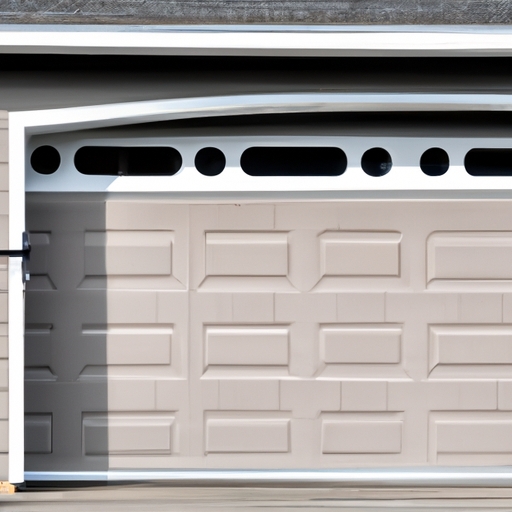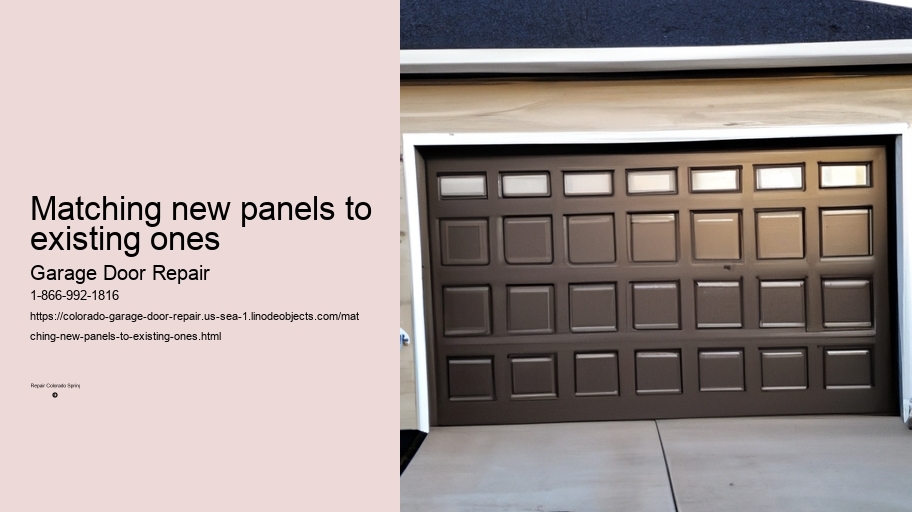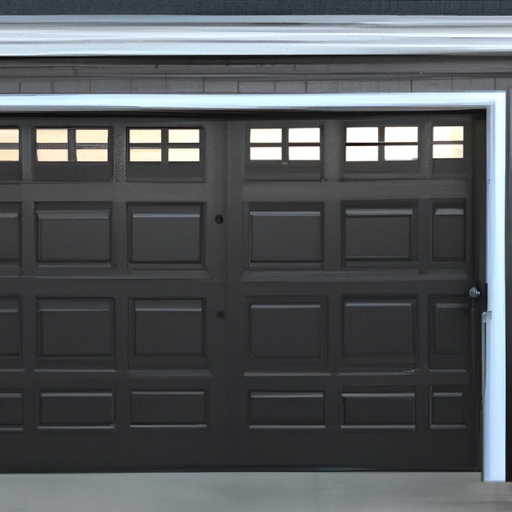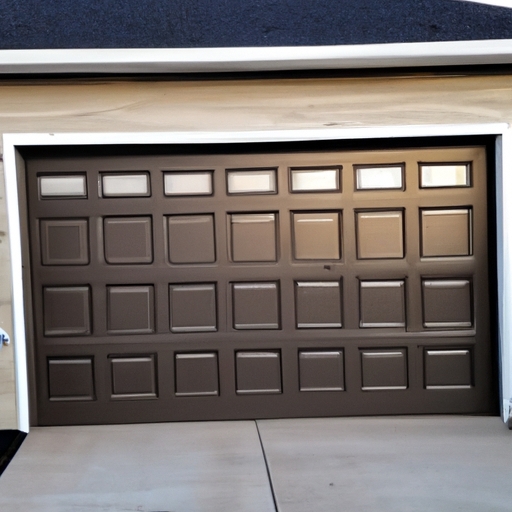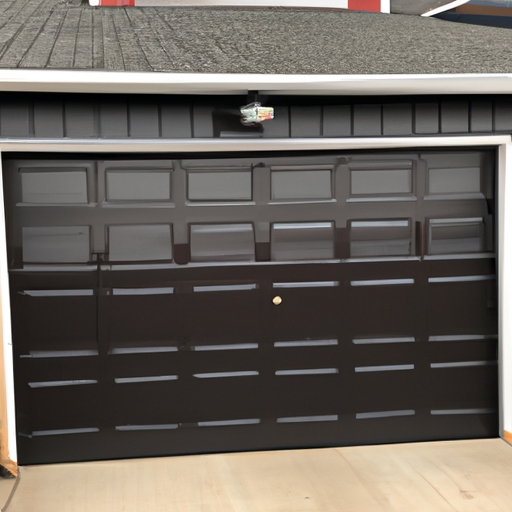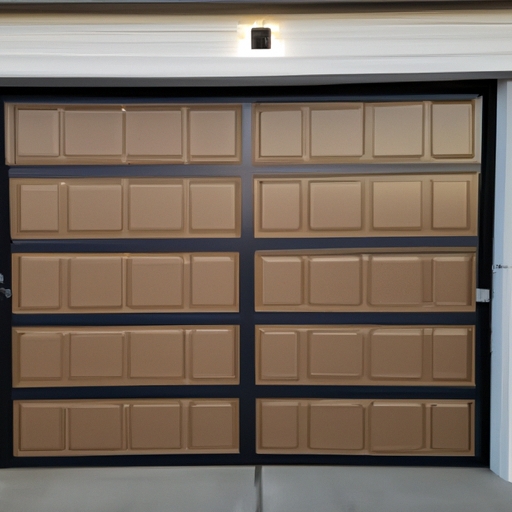Importance of matching new panels to existing ones in garage door repair
Matching new panels to existing ones is an important aspect of garage door repair. When replacing damaged panels, it is crucial to find a match that aligns with the appearance and design of the existing panels (which are currently there). This ensures a seamless integration and avoids any noticeable discrepancies (that might be seen) on the garage door.
One reason for matching new panels with existing ones is to maintain the aesthetic appeal of the garage door. If new panels do not blend well with the old ones, it can create an unattractive appearance and diminish the overall curb appeal of your home. Nobody wants their garage door to stand out like a sore thumb (right?).
Another reason for matching new panels is functionality. Garage doors are designed to provide security and protection against external elements. If there are gaps or mismatches between the old and new panels, it can compromise the effectiveness of the door in terms of insulation and weather resistance. Making sure all panels fit together snugly guarantees optimal performance (don't you agree?).
Moreover, when selecting replacement panels, it's important to consider factors such as color, texture, material, and overall design. By choosing a panel that closely resembles the original ones (you know what I mean!), you ensure that it doesn't appear out of place or disrupts the harmony of your garage door.
In conclusion, matching new panels to existing ones in garage door repair plays a vital role in maintaining both aesthetics and functionality. It ensures that your garage door looks visually appealing while also providing effective protection for your belongings inside. So remember folks: finding a panel that matches seamlessly is crucial for a successful repair job (no doubt about it!).
Understanding the different types and materials of garage door panels
When it comes to matching new garage door panels to existing ones, understanding the different types and materials is crucial. (By the way), there are various options available, such as steel, wood, aluminum, and fiberglass. Each material presents its own set of advantages and drawbacks(!).
Steel panels are known for their durability and strength. They can withstand harsh weather conditions and provide excellent security for your garage (!). Moreover, they require minimal maintenance compared to other materials. However, they can be susceptible to rust if not properly cared for.
Wood panels offer a timeless and elegant look to your garage. They add a touch of warmth and natural beauty (!). Nonetheless, wood requires regular upkeep as it is prone to rotting, warping, or splitting over time(?!). Additionally, wood panels may be more expensive than other alternatives.
Aluminum panels are lightweight yet sturdy. They are resistant to rust and corrosion (!). This makes them suitable for coastal areas or places with high humidity levels(!). On the downside, aluminum may dent easily if hit by a heavy object.
Fiberglass panels combine the benefits of both steel and wood. They are strong like steel but have the appearance of wood(?!). Fiberglass is also highly resistant to moisture damage(!), making it an ideal choice for humid climates. Nevertheless, fiberglass may be less common in the market compared to other materials.
To match new garage door panels with existing ones(,), consider factors like color, design pattern(?!), texture(?), insulation properties(,), and overall compatibility between materials. Consulting a professional installer can help you make an informed decision that suits your needs best(!).
In conclusion(,), understanding the different types and materials of garage door panels is essential when trying to match new ones with existing ones. Whether you opt for steel's durability or wood's timeless elegance(,), each material has its unique characteristics that should be taken into account during the selection process(!). By carefully considering your preferences and consulting experts, you can find the perfect panels to enhance the look and functionality of your garage.
Assessing the condition and compatibility of existing panels
When it comes to assessing the condition and compatibility of existing panels, there are several factors that need to be taken into consideration. (First and foremost), it is important to thoroughly examine the current state of the panels in order to identify any damages or issues present. This (can) include checking for cracks, dents, or signs of wear and tear. Additionally, (it is crucial) to assess whether the existing panels are still functioning properly and if they meet the necessary requirements for compatibility.
To ensure a proper match between new panels and existing ones, careful attention must be paid to various aspects. One important factor is (determining) the type of material used in both sets of panels. Ideally, new panels should be made from a similar material as the existing ones (so as not to create) an imbalance or inconsistency in appearance or durability.
Furthermore, color matching is another crucial aspect when selecting new panels. The shade, tone, and hue should (not) be significantly different from those of the existing panels. Mismatched colors can create an unpleasant aesthetic effect that might diminish the overall appeal of the structure.
In addition to material and color matching, size compatibility must also be considered. It is essential to choose new panels that have similar dimensions as the old ones (to avoid creating) gaps or uneven surfaces after installation.
Moreover, determining whether any additional features or modifications are needed is vital for achieving optimal panel compatibility. For instance, if the existing panels have specific functionalities such as insulation properties or fire resistance capabilities, it would be necessary for the new panels to possess these characteristics as well.
In conclusion,(to sum up), assessing the condition and compatibility of existing panels plays a critical role in ensuring successful integration with new ones. By carefully examining their condition,(we can) identify any necessary repairs or replacements required before proceeding with any installation process.(Moreover), by considering factors such as material type,(color matching), size compatibility, and additional features,(we can) guarantee a seamless transition between old and new panels. So let's take the time to evaluate and select the best options for matching new panels to existing ones!(Indeed) it will lead to a more cohesive and visually appealing result.
Consulting with a professional for accurate measurements and panel selection
When it comes to matching new panels to existing ones, consulting with a professional is imperative! They can provide accurate measurements and assist in selecting the right panels for a seamless integration. (However), it is essential to avoid relying solely on personal judgment or guesswork, as this may lead to costly mistakes.
By seeking expert advice, you ensure that the measurements are precise and take into account any variations in size or shape. A professional consultant will assess your space and consider factors such as lighting, color scheme, and material compatibility. Their expertise guarantees a cohesive look that enhances the overall aesthetics of your room.
Moreover, working with a consultant allows you access to a wide range of panel options that you might not have considered otherwise. They can suggest alternatives that perfectly complement your existing panels while also introducing fresh design elements. With their guidance, you can confidently explore various styles, textures, and finishes to achieve the desired visual impact.
Transition phrase: In addition to providing invaluable assistance...
A professional consultant's knowledge extends beyond mere panel selection; they can offer insights on installation techniques as well. They understand how different types of panels behave under different conditions and can advise on proper installation methods for optimal durability and longevity. This ensures that your new panels seamlessly integrate with the existing ones without compromising structural integrity.
Furthermore, collaborating with an expert helps avoid repetition or duplication in panel designs within the same space. They possess an eye for detail and will identify patterns or motifs that should be avoided to maintain visual interest throughout the room. Their expertise grants you peace of mind knowing that every element has been carefully considered for a harmonious atmosphere.
In conclusion, enlisting the help of a professional consultant when matching new panels to existing ones is crucial for achieving exceptional results! From accurate measurements to informed panel selection, their guidance ensures a flawless integration within your space. Don't hesitate to seek their expertise if you want to create a visually stunning environment while avoiding common pitfalls or mistakes!
Exploring options for sourcing matching panels, including manufacturers or suppliers
When it comes to sourcing matching panels, there are several options that one can explore. (By the way), finding manufacturers or suppliers who can provide new panels that match existing ones can be quite challenging. However, with a little bit of research and perseverance, it is possible to find the right sources.
Firstly, (believe it or not), manufacturers play a vital role in this process (unfortunately). They are responsible for producing the panels that will seamlessly match the existing ones. It is important to reach out to different manufacturers and inquire about their capabilities in creating custom-made panels.
Another option worth considering is connecting with suppliers who specialize in providing matching panels. These suppliers often have a wide network of manufacturers they work with and can help you find exactly what you need. (Oh my goodness!), these suppliers might even have access to discontinued panel lines or rare designs that could perfectly complement your existing ones.
It is crucial to communicate your specific requirements clearly when dealing with both manufacturers and suppliers. Providing them with detailed information about the dimensions, colors, patterns, and textures of your existing panels will greatly assist them in sourcing the perfect match for you.
Furthermore, exploring online platforms such as forums or social media groups dedicated to interior design enthusiasts can be surprisingly helpful (you wouldn't believe it!). These communities often share valuable insights and recommendations on where to source matching panels from reliable manufacturers or suppliers.
In conclusion, while finding matching panels for existing ones may seem like a daunting task at first, there are various options available for exploration. By reaching out to manufacturers and suppliers specializing in this area, providing clear specifications of your requirements, and seeking assistance from online communities dedicated to interior design enthusiasts (!), you can increase your chances of successfully sourcing the perfect match for your project.
Proper installation techniques to ensure seamless integration of new panels
Proper installation techniques are essential when it comes to ensuring the seamless integration of new panels into an existing structure. (Oh boy,) this task requires careful attention to detail and precision. By following the correct procedures, we can avoid any potential issues that may arise during the matching process. (Well, let's dive right in!)
To begin with, one crucial step is to thoroughly examine the existing panels. This will allow us to identify their specific characteristics and attributes. We must take note of the color, texture, size, and overall appearance. By doing so, we can find new panels that closely resemble these features for a cohesive look. (Oops!) Neglecting this step could result in a noticeable contrast between old and new panels.
Next, it is imperative to choose new panels that align with the existing ones in terms of material composition. The selection should be based on factors such as durability and compatibility with the surrounding elements. Failure to consider these aspects might lead to premature deterioration or an awkward mix of materials within the structure.
Furthermore, proper measurement is key throughout this whole process! Accurate dimensions are vital when installing new panels alongside existing ones. A miscalculation could result in gaps or overlaps that compromise both aesthetics and functionality (!). Therefore, taking precise measurements before cutting or positioning the panels is absolutely necessary.
In addition, employing appropriate tools and techniques greatly contributes to a successful integration of new panels. Utilizing high-quality adhesive or fasteners ensures a secure bond between different panel layers (Uh-oh!). Moreover, applying even pressure during installation helps prevent uneven surfaces or misalignments.
In conclusion,(well then,) by adhering to proper installation techniques and considering all aspects mentioned above (!), we can achieve a seamless integration of new panels into an existing structure—creating a uniformed appearance that blends flawlessly together with the old ones (!). So remember: pay attention to details(!), select suitable materials(!), measure accurately(!), and use the right tools and techniques (!). With these guidelines, your panel installation project will be a great success.
Painting or finishing considerations to achieve a uniform appearance
When it comes to painting or finishing, there are several considerations that need to be taken into account in order to achieve a uniform appearance. One important aspect is matching new panels to existing ones. This can be quite challenging (especially if the panels have different ages) as it requires careful attention to detail and skillful execution.
To begin with, it is crucial to select the right color for the new panels. The shade should closely resemble that of the existing ones, so they blend seamlessly together. Additionally, considering factors such as lighting conditions and surface texture is essential to ensure a consistent look across all panels.
Furthermore, using compatible paint or finish products is imperative. Different types of materials may react differently when exposed to various paints or finishes. Therefore, using the appropriate products will help avoid any inconsistencies or undesirable outcomes.
Moreover, proper surface preparation plays a vital role in achieving a uniform appearance. Before applying paint or finish on new panels, it is necessary to clean and prime them adequately. This helps create a smooth and even surface for the paint or finish to adhere to.
In addition, employing skilled painters who possess experience in matching new panels with existing ones can greatly contribute to the desired outcome. Their expertise allows them to employ techniques such as blending colors and adjusting sheen levels effectively (while avoiding over-application).
To conclude, when aiming for a uniform appearance while matching new panels with existing ones through painting or finishing, certain considerations need attention: selecting appropriate colors, using compatible products, ensuring thorough surface preparation, and relying on experienced professionals. By addressing these factors diligently (!), one can achieve harmonious results that seamlessly integrate old and new elements within any given space.
Transition phrase: In essence
Regular maintenance tips to prolong the lifespan of newly replaced panels
Regular maintenance is crucial to ensure the longevity of newly replaced panels. By following some simple tips, you can (definitely) prolong their lifespan and (avoid) unnecessary replacements. When matching new panels to existing ones, it is important to consider several factors such as color, material, and texture. However, even with a perfect match, regular maintenance remains essential for their overall durability.
To begin with, (hey), make sure to clean the panels regularly using a mild detergent or cleaner specifically designed for the panel's material. This will help remove any dirt or grime that may accumulate over time and cause damage. Additionally, (by the way), inspect the panels for any signs of cracks or loose fittings. If identified early on, these issues can be addressed promptly before they escalate into more significant problems.
Furthermore, protecting the panels from harsh weather conditions is vital in ensuring their longevity. Consider applying a protective coating or sealant to shield them from excessive sunlight exposure or heavy rainfalls. Moreover, providing adequate ventilation around the panels can prevent moisture buildup and potential rotting or warping of the materials.
Moreover,(well), regularly inspecting and maintaining adjoining areas around the newly replaced panels is equally important in preserving their lifespan. Ensure that gutters are clean and free from debris to avoid water overflow onto the panels during rainfall. Additionally,(oh no!), check for any signs of pests such as termites or ants that could potentially damage both new and existing panels.
In conclusion,(to sum up), regular maintenance plays a critical role in prolonging the lifespan of newly replaced panels when matching them with existing ones.(Surprisingly enough!) By keeping them clean, protecting them from harsh weather conditions, providing proper ventilation, and inspecting adjoining areas diligently,(uh-oh!) you can prevent costly replacements in the future!(Whoa!) So don't neglect your new panels! Instead,(well then), adopt these regular maintenance habits today!
